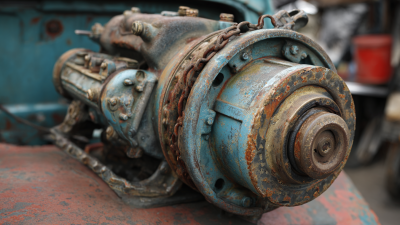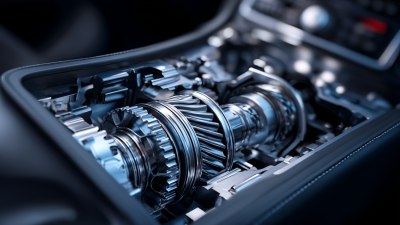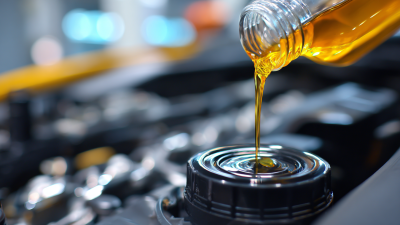The Ultimate Showdown Between Original Auto Parts and Aftermarket Alternatives
In the automotive world, the debate over original auto parts versus aftermarket alternatives remains a hot topic among car enthusiasts and casual drivers alike. Original auto parts are often lauded for their superior quality, precise engineering, and compatibility with specific vehicle models, ensuring that drivers maintain the integrity of their vehicles.

On the other hand, aftermarket alternatives promise cost efficiency and accessibility, appealing to those who seek budget-friendly repairs or upgrades. This blog aims to explore the ultimate showdown between these two options, providing top strategies for making informed decisions.
Whether you prioritize performance, cost, or reliability, understanding the nuances of original auto parts versus aftermarket choices is crucial in navigating the complex landscape of automotive repairs. Join us as we delve into this comprehensive comparison, equipping you with the knowledge to choose the best parts for your vehicle.
Benefits of Using Original Auto Parts: Quality and Reliability
When it comes to vehicle maintenance and repairs, the choice between original auto parts and aftermarket alternatives can significantly impact performance and durability. Original auto parts, often manufactured by the vehicle's maker, are designed to meet specific standards of quality and reliability. One of the main benefits of using these parts is the assurance that they fit perfectly and function seamlessly with your vehicle's existing systems. This compatibility reduces the chances of unexpected breakdowns and enhances the overall driving experience.

Moreover, original auto parts are subjected to rigorous testing and quality control measures that aftermarket options may not undergo. This commitment to quality ensures not only the longevity of the parts themselves but also the safety of the vehicle. For instance, braking systems and engine components must perform optimally to maintain safety on the roads. By choosing original parts, vehicle owners can have peace of mind knowing they are investing in reliable, high-quality components that uphold the integrity of their car.
Cost Considerations: Comparing Original Parts vs. Aftermarket Options
When deciding between original auto parts and aftermarket alternatives, cost considerations often take center stage. Original parts, while typically more expensive, are designed specifically for your vehicle, ensuring a perfect fit and compliance with manufacturer standards. Aftermarket options may come with a lower price tag, but the quality can vary significantly. It's essential to weigh the long-term benefits of investing in original parts against potential savings from aftermarket choices.
**Tip:** Always research the reputation of aftermarket brands before making a purchase. Look for reviews and testimonials from other users to gauge reliability and performance. This can help you identify high-quality aftermarket parts that won’t compromise your vehicle's integrity.
Another cost factor to consider is warranty coverage. Original parts generally come with a manufacturer's warranty, providing peace of mind in case of defects or issues down the line. On the other hand, many aftermarket parts may not offer sufficient warranty protection, which could lead to additional expenses if replacements are necessary.
**Tip:** When shopping for parts, check if the aftermarket part has a warranty. A warranty can be a good indicator of the manufacturer’s confidence in their product and can save you money on potential repairs.
The Ultimate Showdown: Original Auto Parts vs. Aftermarket Alternatives
This chart illustrates the cost comparisons between original auto parts and aftermarket alternatives across five essential components: Engine, Brake Pads, Starter Motor, Alternator, and Shock Absorber. The data reflects average prices collected from various sources.
Performance Impact: How Parts Choice Influences Vehicle Functionality
When it comes to maintaining or upgrading your vehicle, the choice between original auto parts and aftermarket alternatives significantly impacts performance. Original parts, designed specifically for your vehicle’s make and model, offer a level of compatibility and reliability that is hard to match. These components undergo rigorous testing and quality control, ensuring that they function seamlessly with your vehicle’s existing systems. This can result in improved engine performance, better fuel efficiency, and enhanced safety, as they are engineered to meet the same standards as the original parts.
On the other hand, aftermarket parts provide various options at often lower prices, appealing to budget-conscious car owners. However, the performance of these parts can vary widely depending on the manufacturer. While some aftermarket components are high-quality and can enhance vehicle functionality—such as improving horsepower or handling—others may compromise performance and safety. Choosing aftermarket options requires careful research to ensure that you’re selecting a product that meets or exceeds the standards of original parts. Understanding the potential impact on your vehicle's overall functionality is critical in making informed decisions that align with your performance goals.
Warranty Implications: Protecting Your Investment with Original Parts
When considering vehicle maintenance, the implications of using original auto parts versus aftermarket alternativas can significantly impact your warranty. A report from the Auto Care Association highlights that using original manufacturer parts (OEM) can play a critical role in retaining warranty coverage. Approximately 73% of consumers believe that OEM parts are more likely to meet manufacturer specifications, directly affecting long-term vehicle reliability and performance.
Moreover, many manufacturers clearly state in their warranty guidelines that using unapproved aftermarket parts may void the warranty. According to a study by the National Automobile Dealers Association, nearly 60% of dealer service departments report that they often see warranty claims denied due to the use of aftermarket components. This not only raises concerns about vehicle performance but could lead to substantial repair costs down the line, underscoring the importance of protecting your investment with original parts. By choosing OEM, vehicle owners can ensure compliance with warranty requirements while enhancing the longevity and reliability of their vehicles.
Environmental Considerations: Sustainability in Auto Parts Selection
 When selecting auto parts, sustainability has become a pivotal consideration for both consumers and manufacturers. Original equipment manufacturer (OEM) parts are often praised for their quality and reliability, but they are not always the most environmentally friendly option. The production of these parts typically requires significant resources and energy, contributing to a larger carbon footprint. By contrast, aftermarket alternatives often present a more sustainable option. Many aftermarket manufacturers are now focusing on eco-friendly practices, including the use of recycled materials and energy-efficient production methods.
When selecting auto parts, sustainability has become a pivotal consideration for both consumers and manufacturers. Original equipment manufacturer (OEM) parts are often praised for their quality and reliability, but they are not always the most environmentally friendly option. The production of these parts typically requires significant resources and energy, contributing to a larger carbon footprint. By contrast, aftermarket alternatives often present a more sustainable option. Many aftermarket manufacturers are now focusing on eco-friendly practices, including the use of recycled materials and energy-efficient production methods.
Furthermore, choosing aftermarket parts can promote sustainability by extending the life cycle of existing vehicle components. Innovative companies are increasingly offering refurbished parts, which not only reduce waste but also minimize the demand for new parts that require additional raw materials to produce. Consumers who opt for these alternatives not only save money, but they also contribute to a more sustainable automotive ecosystem. This shift in the auto parts market reflects a broader commitment to environmental stewardship, ensuring that vehicle maintenance aligns with the values of sustainability and responsible consumption.
Related Posts
-

Unwavering Quality in the Best Motor Parts from Trusted Chinese Manufacturers
-

What Makes the Best Auto Transmission Essential for Modern Vehicles
-

Unlocking Efficiency: The Advantages of High-Quality Valve Bodies for Global Buyers
-

7 Key Reasons Your Engine Coolant Choice Can Save You Money
-

Top Strategies for Sourcing Quality Automotive Spares Efficiently
-

Engine Parts Comparison Unveiling Reliability and Performance Metrics for Global Buyers